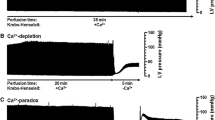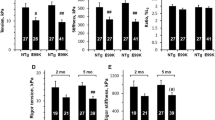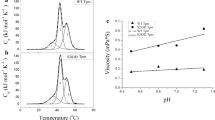Abstract
Work performing heart preparations from hypercontractile, phospholamban deficient mouse hearts showed no change in parameters of contraction or relaxation in response to isoproterenol stimulation. Thus, the aim of the present study was to investigate whether or not changes at the level of the contractile apparatus occur in addition to the altered expression of Ca2+-regulating proteins observed in these mouse models, e. g., phospholamban, ryanodine receptors. Triton-X skinned fiber preparations from phospholamban deficient (n = 9) and wild-type (n = 10) mice were used and the Ca2+-activated force as well as the myosin ATPase-activity were simultaneously measured. The tension dependent ATPase-activity was unchanged in phospholamban deficient animals when compared to controls. The SERCA 2a-inhibitor cyclopiazonic acid did not affect myosin ATPase-activity in this system. The Ca2+-sensitivity of Ca2+-activated force and myosin ATPase were unchanged as well. Comparison of the concentrations needed to achieve half maximal activation of the myosin ATPase-activity and force demonstrated that the Ca2+-sensitivity of the myosin ATPase was higher compared to the Ca2+-sentivity of tension development. This holds true for phospholamban deficient mice (EC50 ATPase: 0.9 ± 0.2 μmol/l; tension: 1.7 ± 0.3 μmol/l; p < 0.001) and wild-type controls (1.1 ± 0.01 μmol/l; 2.2 ± 0.4 μmol/l; p < 0.01). The myosin ATPase-activity and force were correlated to each other in both, phospholamban deficient mice and controls and did not change at submaximal Ca2+ concentrations. The ATPase/force-ratio, as a parameter of tension cost, was similar in either phospholamban deficient mice or controls. Thus, the present study provides evidence that at the level of the contractile proteins regulation of Ca2+-activated force and energy demand of force development are not altered in phospholamban deficient mice with enhanced myocardial performance. At the level of the regulation of crossbridge interaction, no adaptive or compensatory mechanisms have been initiated by ablation of phospholamban.
Similar content being viewed by others
Author information
Authors and Affiliations
Additional information
Received: 22 March 1999, Returned for revision: 26 April 1999, Revision received: 1 July 1999, Accepted: 12 July 1999
Rights and permissions
About this article
Cite this article
Schwinger, R., Brixius, K., Savvidou-Zaroti, P. et al. The enhanced contractility in phospholamban deficient mouse hearts is not associated with alterations in Ca2+-sensitivity or myosin ATPase-activity of the contractile proteins. Basic Res Cardiol 95, 12–18 (2000). https://doi.org/10.1007/s003950050003
Issue Date:
DOI: https://doi.org/10.1007/s003950050003




